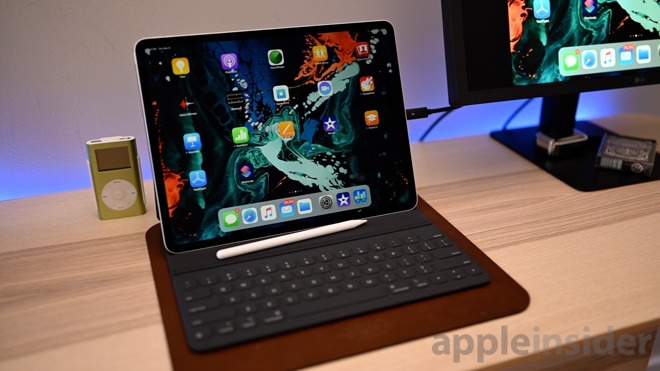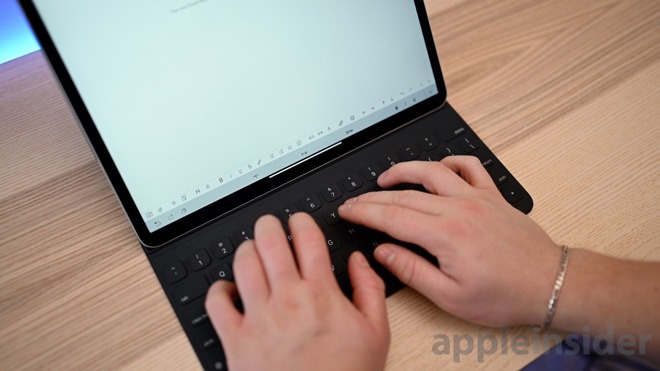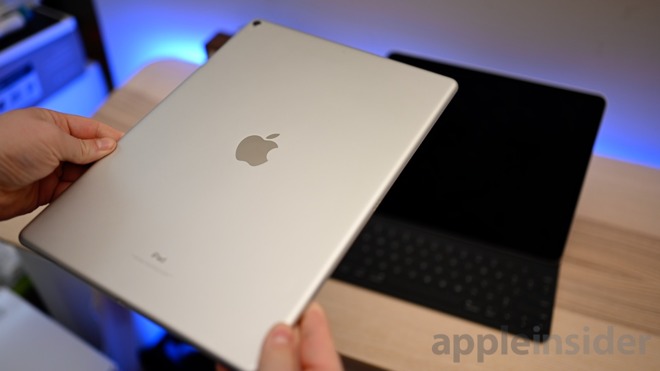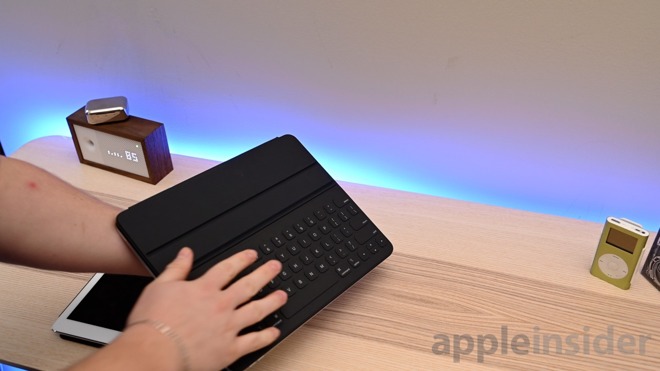Review: Apple's Smart Keyboard Folio is the best option for the iPad Pro, but has too many...
Apple's iPad Pro wasn't the only hardware to receive a major redesign at Apple October event. The iPad Pro Smart Keyboard did too, plus a rebrand ending up in what is now called the Smart Keyboard Folio. After endless hours of tapping away, Apple's iPad keyboard is still the best, but has far too many compromises for our liking.

iPad Pro Smart Keyboard Folio
The Smart Keyboard Folio hooks up to your iPad Pro magnetically. A series of new magnets are embedded within the back panel of the new iPad to make this work. These magnets hold the folio into place, but are still only magnets -- a sharp jolt from a fall still is enough to dislodge it.
What has always made Apple's iPad-centric keyboard somewhat unique was the lack of any moving parts. There is no mechanical or butterfly mechanism moving the keys. The keyboard itself is made of fabric, which is stiffened and reinforced to form the actual key caps.

iPad Pro Smart Keyboard Folio
When it comes to sizes and convenience when typing, there are two models to consider -- the larger 12.9-inch model actually contains a full-sized keyboard, same as the last generation despite it being physically shrunken down. Apple trimmed up the extra space on the sides, retaining the full-keyboard size.
The 11-inch model in comparison is a bit more cramped, and certainly a tough experience. With the 12.9-inch, it feels -- other than the material -- similar to typing on your Mac. Because of the space constraints, the 11-inch isn't a full-sized keyboard so muscle memory is a bit harder to transfer.

iPad Pro Smart Keyboard Folio
I've spent a lot of time typing on the Smart Keyboard over the past couple years and I enjoy them a great deal. They only have subtle audio feedback and don't have a super satisfying click to them, but they are quick and responsive. Because the amount of key travel, the Smart Keyboard Folio actually feels not too dissimilar to the butterfly keyboard on the Mac.
The Smart Connector is how the Smart Keyboard Folio connects to your iPad Pro and draws power, meaning it never needs to be plugged in and charged on its own, unlike Bluetooth models.
The best change the made was simplifying the experience. Propping up the iPad into typing mode is as easy as opening the folio and tilting the iPad back, which then locks into place, again using magnets.

iPad Pro Smart Keyboard Folio
Instead of being limited to one orientation for typing, there are two angles the screen can be placed at.
What amounts to the biggest improvement for us was the increased stability. The previous model had a top panel with the hinge. Flat surfaces were no issue, but trying to type on your lap or the armrest of a couch were tough to do. It was also difficult to pick up the iPad while open in typing mode from the edge of your keyboard, again due to that hinge.
The new model has a completely solid top which fixes all of those complaints. And yes, the new model also comes with some back protection, thus making it the folio rather than just the keyboard.
While Apple has succeeded in making a number of improvements, they've also introduced a number of new downsides.

iPad Pro Smart Keyboard Folio
We are disappointed Apple is forcing the back protection upon us for this product which adds unnecessary weight and thickness to the combined unit for not enough in return. The new iPad Pro and Smart Keyboard Folio weighs more, and is thicker than the old iPad Pro and Smart Keyboard combination. This is a strange choice given that the the new iPad Pro by itself is thinner than the previous year.
We'd have preferred an optional implementation. Perhaps one with a separately sold magnetic back panel to go with the Smart Keyboard.

iPad Pro Smart Keyboard Folio
Another issue we had was when folding the keyboard back behind the iPad. This happens a lot when we just use it as a tablet and aren't using the keyboard or propping it up. On the old model, you had a panel of microfiber against your hand which supplied more grip. The new one feels awkward when holding.
To compound things, those keys facing backward actually makes the iPad slide a bit in this situation when sitting on different surfaces. The previous microfiber helped it stay in place. Many times we pick up our open iPad, set it on our Mac, and walk around the house or office. The combination now slides around while in transit, rather than staying put.

iPad Pro Smart Keyboard viewing mode
Our biggest complaint is the more vertical viewing mode. The old iPad Pro had two modes -- a typing mode with the keyboard out, then a viewing mode that tucked the keyboard away and positioned the iPad at a steeper angle. This was convenient to use with a small footprint in a variety of scenarios and took up very little space.

iPad Pro Smart Keyboard Folio vertical mode
On the new iPad Pro with the Smart Keyboard Folio, you still have this more vertical angle, but you have the keyboard out at the same time. This ends up occupying a large amount of unnecessary space.
Since we've started using the new model, it has been exceedingly frustrating to use and we wish Apple didn't remove the capability.

iPad Pro Smart Keyboard Folio
We're hoping that manufacturers are rushing to bring their own keyboards to the new iPad Pros -- but aren't optimistic given the dearth of options for the iPad Pro. But, with any luck, Apple will be dethroned by a newcomer this year.

iPad Pro Smart Keyboard Folio
Smart Keyboard basics
This is a simple folio, and not necessarily a full-blown case.The Smart Keyboard Folio hooks up to your iPad Pro magnetically. A series of new magnets are embedded within the back panel of the new iPad to make this work. These magnets hold the folio into place, but are still only magnets -- a sharp jolt from a fall still is enough to dislodge it.
What has always made Apple's iPad-centric keyboard somewhat unique was the lack of any moving parts. There is no mechanical or butterfly mechanism moving the keys. The keyboard itself is made of fabric, which is stiffened and reinforced to form the actual key caps.

iPad Pro Smart Keyboard Folio
When it comes to sizes and convenience when typing, there are two models to consider -- the larger 12.9-inch model actually contains a full-sized keyboard, same as the last generation despite it being physically shrunken down. Apple trimmed up the extra space on the sides, retaining the full-keyboard size.
The 11-inch model in comparison is a bit more cramped, and certainly a tough experience. With the 12.9-inch, it feels -- other than the material -- similar to typing on your Mac. Because of the space constraints, the 11-inch isn't a full-sized keyboard so muscle memory is a bit harder to transfer.

iPad Pro Smart Keyboard Folio
I've spent a lot of time typing on the Smart Keyboard over the past couple years and I enjoy them a great deal. They only have subtle audio feedback and don't have a super satisfying click to them, but they are quick and responsive. Because the amount of key travel, the Smart Keyboard Folio actually feels not too dissimilar to the butterfly keyboard on the Mac.
The Smart Connector is how the Smart Keyboard Folio connects to your iPad Pro and draws power, meaning it never needs to be plugged in and charged on its own, unlike Bluetooth models.
What's new
Apple didn't just shrink down their existing keyboard for the smaller 12.9-inch iPad Pro, they instead took this as an opportunity to try to improve upon it.The best change the made was simplifying the experience. Propping up the iPad into typing mode is as easy as opening the folio and tilting the iPad back, which then locks into place, again using magnets.

iPad Pro Smart Keyboard Folio
Instead of being limited to one orientation for typing, there are two angles the screen can be placed at.
What amounts to the biggest improvement for us was the increased stability. The previous model had a top panel with the hinge. Flat surfaces were no issue, but trying to type on your lap or the armrest of a couch were tough to do. It was also difficult to pick up the iPad while open in typing mode from the edge of your keyboard, again due to that hinge.
The new model has a completely solid top which fixes all of those complaints. And yes, the new model also comes with some back protection, thus making it the folio rather than just the keyboard.
While Apple has succeeded in making a number of improvements, they've also introduced a number of new downsides.
You can't always get what you want
The first downside, which is more likely a personal issue, is the back protection. We take our iPads everywhere. We travel a lot and are always bringing them along for the ride, often with the original Smart Keyboard in tow. After a year of doing that with our second generation iPad Pro, there are still no scratches or scuffs on the back of our iPad.
iPad Pro Smart Keyboard Folio
We are disappointed Apple is forcing the back protection upon us for this product which adds unnecessary weight and thickness to the combined unit for not enough in return. The new iPad Pro and Smart Keyboard Folio weighs more, and is thicker than the old iPad Pro and Smart Keyboard combination. This is a strange choice given that the the new iPad Pro by itself is thinner than the previous year.
We'd have preferred an optional implementation. Perhaps one with a separately sold magnetic back panel to go with the Smart Keyboard.

iPad Pro Smart Keyboard Folio
Another issue we had was when folding the keyboard back behind the iPad. This happens a lot when we just use it as a tablet and aren't using the keyboard or propping it up. On the old model, you had a panel of microfiber against your hand which supplied more grip. The new one feels awkward when holding.
To compound things, those keys facing backward actually makes the iPad slide a bit in this situation when sitting on different surfaces. The previous microfiber helped it stay in place. Many times we pick up our open iPad, set it on our Mac, and walk around the house or office. The combination now slides around while in transit, rather than staying put.

iPad Pro Smart Keyboard viewing mode
Our biggest complaint is the more vertical viewing mode. The old iPad Pro had two modes -- a typing mode with the keyboard out, then a viewing mode that tucked the keyboard away and positioned the iPad at a steeper angle. This was convenient to use with a small footprint in a variety of scenarios and took up very little space.

iPad Pro Smart Keyboard Folio vertical mode
On the new iPad Pro with the Smart Keyboard Folio, you still have this more vertical angle, but you have the keyboard out at the same time. This ends up occupying a large amount of unnecessary space.
Since we've started using the new model, it has been exceedingly frustrating to use and we wish Apple didn't remove the capability.
Still the best
Regardless of all our complaints, the Smart Keyboard Folio remains the best typing experience on iPad. The keys are quick, responsive, and easy to type on. They aren't as satisfying as some dedicated keyboards, but once you adjust, you can touch type as quickly and as accurately as on your Mac.
iPad Pro Smart Keyboard Folio
We're hoping that manufacturers are rushing to bring their own keyboards to the new iPad Pros -- but aren't optimistic given the dearth of options for the iPad Pro. But, with any luck, Apple will be dethroned by a newcomer this year.


Comments
I think you criticisms are completely fair. They are personal preferences, but I think those matter greatly. When I say I really enjoy typing on this keyboard other reviewers may hate it. That’s a personal preference. As is how it feels. My criticisms come from a lot of use of this product, more so than most other reviewers out there who solely use the keyboard during a brief review period. These criticisms can be make or break for some people. After using the previous Smart Keyboard about every day for two years, this new model has me looking for new options. I’d consider that relevant for a review.
We all have our own opinions - and that’s a good thing. Mine differs wildly from the author’s.
I did not really much like the 10.5 Smart Keyboard. And to me the new one for the 11” is a big improvement in multiple ways:
- multiple display angles
- much more solid when typing, including on your lap, where the old one was prone to collapse at any moment (#1 improvement!)
- you can pick it up and move it around without it falling apart like the old one
- the key action seems to me to have just a touch more travel - I like it a lot, and can write for several hours on it without any major issues
- keyboard section seems stronger and stiffer - if you are silly enough to pick the system up by that protruding keyboard section, the old system would bend a lot, whereas the new one does not.
I would rate the old solution for the 10.5” at about a 6/10 (light, thin, decent key action) - whereas for me the new solution gets an 8/10 (to me pretty much all the same benefits of the old one, plus vastly more solid in use, with more viewing angle options).
I agree the fold over with keys facing outward is kind of odd. But the two sides join quite solidly, again via magnets, and the keys are reliable in not being active, so i just accept them as grip - or pull it off and put it in my bag if mobile, or to one side if at home.
My wife is also a user of both old and new solutions, and feels just the same as I do - so I feel justified in thinking I’m not the only one with this opinion
I agree vastly. I’m going to miss this. I wish someone would make a third party Smart Keyboard that mimics the original Apple design.
I was resisting the sarcastic remark to rogifan, but... all of computing since sometime before 1984 or so used computers without trackpads, without mice.
Man, the tab key was used a lot for deployed DOS apps. You can still see some of this UI style today, like in hospital software. A lot of hospital workers are carrying these fully modern touchscreen 2-in-1 laptops, but they end up entering information in a character based UI system built from 30 years ago. I can’t imagine what type of Frankenstein’s monster they have for the backend. Now, it’s only used to begin paragraphs, for those who choose not to have a new line separate paragraphs. The iOS software keyboard on the 10.5 doesn’t even have it as a default key, and I don’t think it is even available for a text field key in web browsers.
I like the old Smart Keyboard a lot but I never liked that bump where the keyboard folds in and find it a little fiddly to fold out, especially into "media viewing" mode. This review confirms all the things that I felt were wrong with this version of the Smart Keyboard. I'm actually happy that I bought early and missed out on the update.
I was waiting for a Mac mini update so I could replace my 6 year old Windows 10 desktop but the updated mini is far too expensive for what I'll use it for so I'll replace my desktop with another Windows 10 PC but that's another story.
Which is it?
What Apple said is true. Touching a vertical screen, be it either a desktop display or a laptop display, is a terrible experience. At best, it should only be used as a complimentary input, which indeed it is for touchscreen clamshells. They should not produce a Mac laptop with a touchscreen. They may produce a tabletop touchscreen device in the future, but that will be a device that is flat on a table or inclined like a drafting table.
Apple, like virtually every company, is pragmatic and will produce compromise products to meet certain perceived customer needs and product features given time, resources, and will. External keyboards are one them. The Smart Keyboard for the iPad Pro was not the first Apple keyboard for iPads. It was this:
This was the Apple keyboard dock for the very first iPad in 2010. Apple was thinking of shipping an iPad with two 30 pin ports, likely so that they could dock it in landscape. So, a certain niche of folks really want a hardware keyboard, or Apple perceives that they have been necessary since the very first iPad.
Most people should be using the software keyboard, and Apple should be putting a lot more effort into optimizing the software keyboard. I think it would be more beneficial for Apple to advertise the iPad with its onscreen keyboard a lot more, and leave the keyboard accessories to 3rd parties. Their focus really should be the capabilities of the onscreen keyboard.
I sometimes wonder if there really is a good solution for this, but my opinion is that Apple should add a trackpad to the iPad keyboard and have it work only for text editing and for apps that specifically support it. I think that would add a TON of usefulness without many downsides. But, unfortunately, I'm not in charge at Apple.
I have found that there are some things for which a tablet works quite well, others not so much. I agree with the other commenters, though - no one has found a good balance between the two. What I found using my iPad Pro w/keyboard was that I use a lot of keyboard shortcuts, so I don't need to touch the screen much. As such, it's not such an issue with the usability. The big compromise with a tablet is the fact that while your finger is conveniently attached to your hand, it's not very precise, so things like text selection tend to be rather cumbersome. iOS would need a significant upgrade if it were to allow trackpad or mouse input, though.
Rogifan - clearly a tablet isn't for you! I also find lifting my hand from the keyboard to use a mouse annoying, so I tend to use keyboard shortcuts as much as possible. The interesting thing I have noticed, though is that after using my iPad for a while, I find myself reaching up and touching the screen on my MacBook!